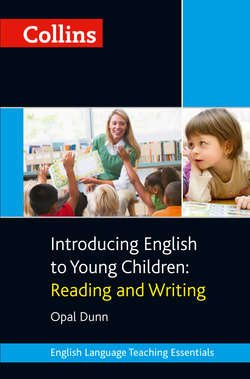Читать книгу Collins Introducing English to Young Children: Reading and Writing - Opal Dunn - Страница 6
About this book
ОглавлениеIn the evolution of man spoken language preceded written language.
(Anon)
Introducing English to Young Children: Reading and Writing gives guidance for the transition period from pre-school English experiences to the more formal first years of written literacy in lower-primary education, up to the age of 8 or 9.
At this lower-primary age there are noticeable holistic and developmental changes, not only physical, but in attitude. Children start to feel they are more grown up. They want to be independent doers and learners. They are beginning to be aware of themselves and what they can do, and how, with effort, they can achieve and make progress. They need help to progress and to develop their own autonomy and we, as teachers, need to tune in to them and listen to their needs if they are to mature holistically and feel good.
For the child, English is still not a school subject; it’s another way of communicating and talking within the class, school and beyond. Young children continue to pick up English in the same way as they learned their first language (L1), if the adult helping inserts the Playful Approach to motivate them. However, language content and enabling activities, although more advanced, are still linked to self-discovery.
The teacher’s role remains important, as the teacher is still the main source of new input of English. However, teacher-talk has broadened to introduce a wider vocabulary through mediating and modelling situations. Direct teaching is now included in quick, focused tutor-talks that give explanations about language. Young children need help to develop their self-learning strategies if they are to become independent learners.
Young readers, who have developed their own multi-strategies to read, spell and write in L1, are impatient to do the same in English. Since they already understand the mechanics of reading, there is no need to teach them in the same way as non-reader English children. Readers only need help to find out how to transfer and reuse their existing reading strategies to read a new content. Once introduced to a multi-strategy approach to decoding English that they can speak, these children teach themselves to read. They have no need to start, like English-speaking non-readers, from the very beginning of the Synthetic Phonics Method.
Learning language continues to depend on the triangle (consisting of child, teacher and parent) for interactive support and motivation. Suggestions are made for how to involve parents’ innate language-teaching skills in the home to consolidate children’s learning. The window of opportunity to help children absorb English with enthusiasm is limited. By the age of 10, with the onset of puberty and the influence of peer-group pressures, their learning environment changes.
This book is about helping children acquire a good grounding in the basics of reading and writing English – and enjoying it. The many explanations and practical suggestions can be used to support a textbook or a teacher planning a school programme. What I have written is what I have observed, experienced and enjoyed with young children.
There is no substitute for caring human interaction and adult help for learning at this stage. However, as teachers we have to be aware of the increasing appeal of screens. To keep children’s interest, we need to fire up and then stoke children’s curiosity about the world in which they will need English.
Help me to do it myself.
(Montessori)
